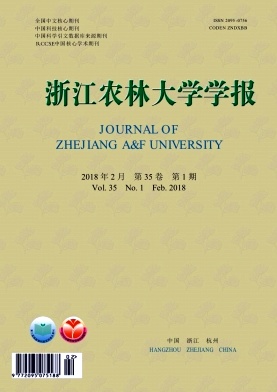-
小麦Triticum sestivum是中国最重要的粮食作物,小麦生产关系到国家粮食安全。麦田杂草对小麦生产造成了巨大的影响,如何有效地防控麦田杂草已成为农业生产中亟待解决的问题[1]。利用植物化感作用控制田间杂草被认为是环境友好型、可持续农业发展的新技术,已成为当代农业生态学研究中的重要领域之一[2-3]。诸多研究证明,小麦具有一定的化感潜力[4-9]。节节麦Aegilops tauschii为禾本科Poaceae山羊草属Aegilops 1年生或越年生植物,起源于东欧、西亚等地,是世界恶性杂草[10]。自1955年,节节麦首次在中国河南省新乡市被发现并采集到标本,如今已入侵中国陕西、山东、河北等地,并呈迅速蔓延的态势。由于节节麦与小麦亲缘关系较近,两者又具有类似的外部形态及生长习性,更重要的是节节麦拥有较强的分蘖、繁殖及适应性等特点,共同造成其成为麦田中最难防除的禾本科恶性杂草之一[11-12]。因严重威胁中国粮食生产安全,节节麦已被列入《中华人民共和国进境植物检疫性有害生物名录》。至今,未见有节节麦响应小麦化感作用的研究报道。为此,本研究以小麦不同部位水浸提液对节节麦种子萌发及幼苗生长的影响,揭示小麦化感作用机理,为麦田节节麦等杂草防控提供参考依据。
HTML
-
试验于2016年6-9月进行。节节麦种子采自洛阳市周山森林公园后山麦田,34°63′N,112°38′E,以洛阳地区常用小麦品种‘洛麦28’为供体。
-
选取生长良好的小麦全株,分别剪取茎叶和根系,蒸馏水冲洗后阴干剪碎,各准确称取100 g定容至1 L,25 ℃浸提24 h,双层滤纸过滤除去植株残体制得质量浓度为100 g·L-1的母液,用蒸馏水分别稀释成5,10,25,50,100 g·L-1的浸提液,置4 ℃冰箱保存备用。使用时提前取出在室内静置一段时间,避免骤冷对种子造成影响。
-
选取大小均匀、籽粒饱满的节节麦种子,用质量浓度为1%的次氯酸钠溶液浸泡10 min消毒,用蒸馏水反复冲洗后在室内自然晾干,置于铺有2层滤纸的培养皿(直径12 cm)内,50粒·皿-1,分别加入不同质量浓度的浸提液5 mL,称量并记录各皿质量。以等量蒸馏水处理为对照,重复3次·处理-1。在昼/夜温度为25 ℃/18 ℃,光暗各12 h的光照培养箱进行培养。隔24 h统计1次种子萌发情况(以胚根突破种皮为萌发标准),第7天统计萌发率,并随机取10株幼苗测定苗高、根长。试验期间适量补充浸提液以保持各处理培养皿质量不变。
-
将经过预萌发处理的小麦种子移栽至盛有适量石英砂的塑料杯(直径10 cm,高度15 cm)中,10粒·杯-1,随后加入10 mL不同质量浓度的浸提液,以加入等体积蒸馏水的为对照,重复3次·处理-1。置于昼/夜温度为25 ℃/18 ℃,光暗各12 h的光照培养箱进行培养。培养15 d后,选取生长一致的叶片进行各项生理指标的测定。参照邹琦[13]电导法进行电解质渗透率的测定(相对电导率,REC)。参照李合生[14]的方法测定叶绿素(Chl)质量分数,酸性茚三酮法测定脯氨酸(Pro);硫代巴比妥酸(TBA)法测定丙二醛(MDA)质量摩尔浓度;氮蓝四唑(NBT)法测定超氧化物歧化酶(SOD)。
-
发芽率RG=(7 d内供试种子发芽数/供试种子数)×100%。参照WILLIAMSON等[15]的方法计算化感效应指数IR = 1-C/T(T≥C)或IR= T/C-1(T<C)。式中,C为对照值,T为处理值。IR>0为促进作用,IR<0为抑制作用,其绝对值大小反映化感作用的强弱[13]。其中,相对电导率与丙二醛质量摩尔浓度所测值越大表明化感抑制作用越强,因此在计算IR时乘以“-1”[16]。综合化感效应(ES)为供体植物对受体植物的各个测试指标IR的算术平均值[17]。本研究通过综合化感效应(ES)反映不同部位浸提液对小麦幼苗化感效应的强弱,其计算公式为ES=(IR 根长+IR 苗高+IRREC+IRChl+IRSOD+IRPro+IRMDA)/7。
-
利用Excel 2010软件处理数据并绘图,SPSS 18.0进行统计分析。
1.1. 材料
1.2. 试验方法
1.2.1. 水浸提液的制备
1.2.2. 种子萌发试验
1.2.3. 生理指标的测定
1.2.4. 数据处理
1.3. 数据统计分析
-
随浸提液质量浓度的增加,节节麦种子发芽率呈先升后降的变化(图 1A)。浸提液质量浓度为5~10 g·L-1,不同部位水浸提液处理的种子发芽率均略有增加,但与对照差异均不显著(P>0.05);之后,发芽率均呈下降变化,至100 g·L-1时,与对照差异均达到显著水平(P<0.05),其中,茎叶水浸提液处理下降了50.0%,而根系处理则下降了45.0%。化感效应指数显示(图 1B):小麦不同部位水浸提液对节节麦种子萌发整体表现为“低促高抑”的化感效应。浸提液质量浓度为25~100 g·L-1时,对种子萌发的化感抑制作用为茎叶>根系。
-
节节麦幼苗苗高随水浸提液质量浓度的增加呈先升后降的变化(图 2A),但小麦茎叶和根系不同质量浓度水浸提液的处理下,幼苗苗高与对照差异均不显著(P>0.05)。化感效应指数的变化显示(图 2B):小麦不同部位水浸提液对节节麦幼苗苗高呈“低促高抑”的化感效应。25~100 g·L-1茎叶水浸提液处理对幼苗苗高表现出质量浓度效应的化感抑制作用,且均明显大于根系水浸提液处理。
-
节节麦幼苗根长随水浸提液质量浓度的增加整体呈先升后降的变化,茎叶和根系水浸提液质量浓度达50 g·L-1及以上时,幼苗根长较对照下降达到差异显著水平(图 3A,P<0.05)。化感效应指数显示(图 3B):小麦不同部位水浸提液对节节麦幼苗根长有“低促高抑”的化感作用。10~50 g·L-1质量浓度下对节节麦根长的化感抑制作用为茎叶<根系,而在100 g·L-1时,则为茎叶>根系。
-
① 叶绿素质量分数。随水浸提液质量浓度的增加节节麦幼苗叶绿素质量分数整体呈下降趋势(图 4A)。低质量浓度(5~25 g·L-1)的水浸提液处理,叶绿素质量分数下降缓慢;水浸提液质量浓度达到50 g·L-1时,小麦不同部位水浸提液处理叶绿素质量分数与对照差异均达显著水平(P<0.05)。至100 g·L-1,小麦茎叶和根系水浸提液处理的叶绿素质量分数较对照分别下降了53.8%,48.4%。②相对电导率。随小麦水浸提液质量浓度的增加,节节麦幼苗相对电导率呈持续升高的趋势(图 4B),表明细胞膜透性不断增大。5~10 g·L-1范围内,不同部位水浸提液处理下相对电导率增加相对缓慢,与对照差异均未达到显著水平(P>0.05),之后,随水浸提液质量浓度的持续增加,相对电导率与对照差异均达显著水平(P<0.05)。至100 g·L-1,茎叶和根系水浸提液处理相对电导率分别较对照增加了2.1倍和1.8倍。③脯氨酸质量分数。随小麦水浸提液质量浓度的增加节节麦幼苗脯氨酸质量分数整体呈不断升高的趋势(图 4C)。茎叶和根系水浸提液处理中,脯氨酸质量分数与对照差异达到显著水平(P<0.05)的起始质量浓度分别为25 g·L-1,10 g·L-1。至100 g·L-1,茎叶和根系水浸提液处理脯氨酸质量分数分别较对照增加了68.2%,71.0%。④SOD活性。从图 4D可以看出:随小麦水浸提液质量浓度的增加节节麦幼苗SOD活性不断升高。茎叶和根系水浸提液处理中,SOD活性与对照差异达显著水平(P<0.05)的起始质量浓度均为10 g·L-1。50~100 g·L-1下,SOD活性增加缓慢;100 g·L-1与50 g·L-1浸提液处理下的SOD活性差异不显著(P>0.05)。⑤丙二醛质量摩尔浓度。随小麦水浸提液质量浓度的增加节节麦幼苗丙二醛质量摩尔浓度呈不断升高的趋势(图 4E)。5 g·L-1不同部位水浸提液处理下的丙二醛质量摩尔浓度与对照差异均不显著(P>0.05)。之后,随着水浸提液质量浓度的持续增加,节节麦幼苗丙二醛质量摩尔浓度不断升高,且与对照差异均达到显著水平(P<0.05)。至100 g·L-1,小麦茎叶和根系水浸提液处理丙二醛质量摩尔浓度较对照均增加了1.2倍。
-
对节节麦幼苗苗高、根长以及叶绿素质量分数、相对电导率等生理指标进行综合分析,可反映小麦茎叶和根系水浸提液对节节麦幼苗的总体化感作用。从综合化感效应值可以看出(表 1):茎叶水浸提液对节节麦幼苗表现为化感抑制作用,而根系水浸提液则呈“低促高抑”的化感作用;化感抑制作用均随水浸提液质量浓度的增加而增大;相同水浸提液质量浓度条件下,茎叶水浸提液处理的化感效应值均大于或等于根系水浸提液,表明小麦水浸提液对节节麦幼苗的化感作用为茎叶≥根系。
部位 ρ水浸提液/(g·L-1) IR 苗高 IR 根长 IRREC IR 叶绿素 IRSOD IRPro IRMDA 综合效应(Es) 茎叶 5 0.04 0.12 -0.28 -0.09 0.05 0.09 -0.07 -0.02 10 0.03 0.06 -0.25 -0.11 0.17 0.19 -0.27 -0.03 25 -0.11 -0.08 -0.48 -0.14 0.24 0.32 -0.41 -0.09 50 -0.16 -0.17 -0.62 -0.46 0.32 0.36 -0.48 -0.17 100 -0.19 -0.43 -0.68 -0.54 0.36 0.41 -0.55 -0.23 根系 5 0.06 0.01 -0.10 -0.03 0.09 0.11 -0.05 0.01 10 -0.08 -0.16 -0.12 -0.07 0.20 0.23 -0.21 -0.03 25 -0.09 -0.17 -0.43 -0.12 0.26 0.31 -0.33 -0.08 50 -0.11 -0.31 -0.55 -0.36 0.33 0.36 -0.42 -0.15 100 -0.16 -0.38 -0.65 -0.48 0.37 0.42 -0.54 -0.20 Table 1. Synthesis effects of aqueous extracts from wheat on t he seedlings of Aegilops tauschii
2.1. 小麦水浸提液对节节麦种子萌发的影响
2.2. 小麦水浸提液对节节麦幼苗生长的影响
2.2.1. 对幼苗苗高的影响
2.2.2. 对幼苗根长的影响
2.2.3. 对幼苗生理指标的影响
2.2.4. 小麦水浸提液对节节麦的综合化感效应
-
化感作用作为植物的一种竞争手段,广泛存在于多种生态系统[18]。化感物质通过作用于种子萌发、幼苗生长等不同生育阶段,对受体植物造成影响[19-21]。本研究表明:小麦不同部位水浸提液对节节麦种子的萌发及幼苗生长存在明显的化感作用,茎叶和根系之间又存在一定的差异,这可能与植物不同器官的化感物质含量及种类不同有关[22]。
种子萌发对物种更新至关重要,发芽率的降低会降低植物在群落中的多度和竞争力[23]。幼苗阶段是植物生命周期中最为关键的时期之一,也是对外界逆境较为敏感的时期[24]。本研究表明:小麦不同部位水浸提液对节节麦种子发芽率、幼苗苗高及根长生长均表现为“低促高抑”的化感作用,且化感抑制作用随浸提液质量浓度的增加而增大。从化感效应指数可知:25~100 g·L-1处理下小麦水浸提液对节节麦种子发芽率及幼苗苗高,以及100 g·L-1处理下对幼苗根长的化感抑制作用均为茎叶>根系,这与小麦对其他植物化感作用研究结果一致[1, 25]。此外,小麦不同部位水浸提液处理对节节麦根长的化感抑制作用大于苗高,这与郑丽等[26]对紫茎泽兰Eupatorium adenophorum,李富荣等[27]对几种菊科Compositae入侵植物的研究结论一致,可能与根系最先接触化感物质有关。供体植物通过对受体植物根长生长的抑制,降低根对水肥等土壤资源的有效利用,从而最终影响其生长发育及在群落中的地位[21]。
细胞膜是植物化感物质作用的起始点[28-29]。逆境胁迫导致细胞内活性氧含量增加,从而造成氧化伤害,膜结构和功能的改变必然会影响细胞内叶绿素、蛋白质等物质的合成,从而影响幼苗的生长[28]。朱慧等[30]对高寒草场主要牧草、田学军等[31]对肿柄菊Tithonia diversifolia的化感作用研究发现,化感胁迫对受体植物细胞膜的结构功能造成破坏,导致细胞电解质的大量外渗,从而造成相对电导率的不断增大。本试验表明:节节麦幼苗相对电导率表现出类似的变化规律。本试验中,随水浸提液质量浓度的增加,节节麦幼苗叶绿素质量分数明显下降,可能与化感胁迫导致叶绿素合成减缓或分解加快有关,这也与黄玉梅等[32]对孔雀草Tagetes patula,郑洁等[33]对白三叶Trifolium repens的研究结果一致。植物通过脯氨酸、可溶性糖等渗透调节物质含量的增加,降低细胞的渗透势,从而适应外界的逆境胁迫[34]。刘瑞姣等[35]对桔梗Platycodon grandiflorum,黄凯丰等[36]对甜荞Fearta esculenium的化感作用研究发现,脯氨酸质量分数均随浸提液质量浓度的增加而呈不断升高的变化。本研究中节节麦幼苗脯氨酸质量分数呈类似的变化规律。化感胁迫破坏了植物体内抗氧化系统与活性氧之间的平衡,从而造成膜脂过氧化作用的发生[37]。SOD作为细胞内活性氧清除的重要酶之一,对膜系统的稳定起着重要作用。本试验中,节节麦幼苗通过SOD活性的不断增加抵御小麦茎叶和根系水浸提液的化感胁迫,这也与前人的研究结果一致[38-39]。其中,100 g·L-1处理与50 g·L-1处理的SOD活性差异不显著(P>0.05),表明高质量浓度浸提液处理下节节麦幼苗SOD活性增加缓慢,可能与过渡的化感抑制导致SOD活性逐渐下降有关。丙二醛作为膜脂过氧化的主要产物之一,其质量摩尔浓度的高低可直接反映细胞膜脂过氧化程度及植物的受胁迫程度[40]。节节麦幼苗丙二醛随小麦不同部位水浸提液质量浓度的增加呈不断升高的变化,这与张志忠等[41]对空心莲子草Alternanthera philoxeroides,葛婷婷等[42]对高粱Sorghum的化感作用研究结论一致。其5 g·L-1小麦不同部位水浸提液处理下,节节麦幼苗丙二醛质量摩尔浓度增加缓慢,与对照差异不显著(P>0.05),这可能与节节麦自身调节适应相关;之后,丙二醛质量摩尔浓度的快速上升与小麦化感物质持续积累,造成膜脂过氧化程度加重有关。
综合化感效应已被广泛地应用于植物化感作用研究[43-45]。从综合化感效应值可知,小麦茎叶水浸提液对节节麦幼苗整体呈化感抑制作用,而根系水浸提液则表现为“低促高抑”的化感作用。小麦不同部位相同质量浓度水浸提液对节节麦幼苗的化感抑制作用强弱为茎叶≥根系。本研究仅在室内条件下,结合节节麦种子萌发及幼苗生长等相关指标的测定,证实了小麦茎叶和根系化感效应的存在,实际情况中小麦释放化感物质的途径很多,且自然条件中影响化感物质的环境因素也较多[46],因此,加强田间条件下小麦对节节麦等杂草的化感效应研究将为阐明小麦的化感除草作用提供参考依据。












 DownLoad:
DownLoad: